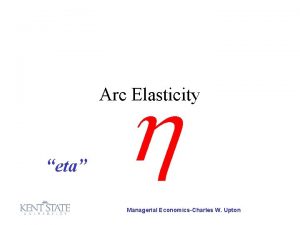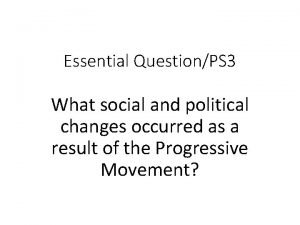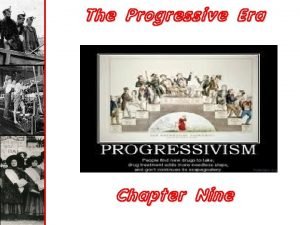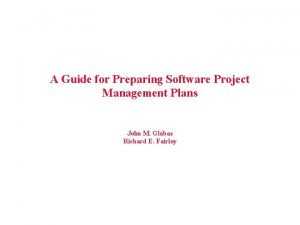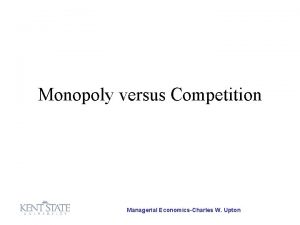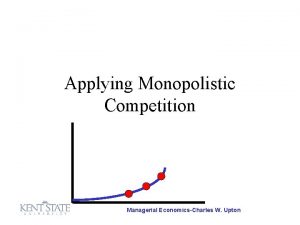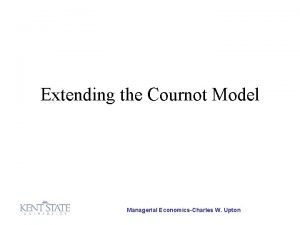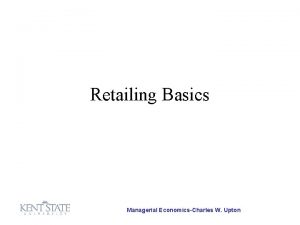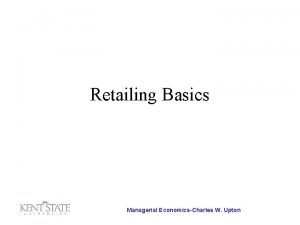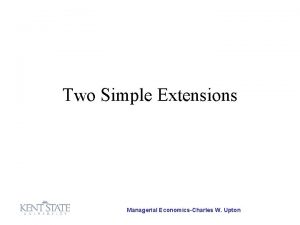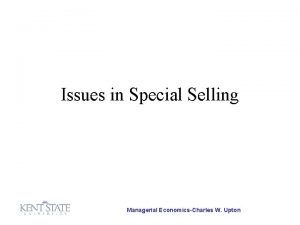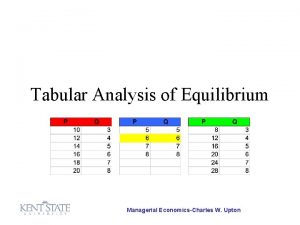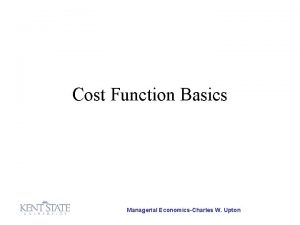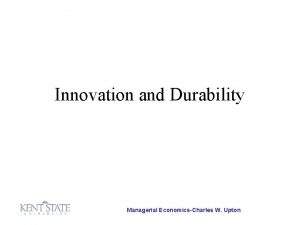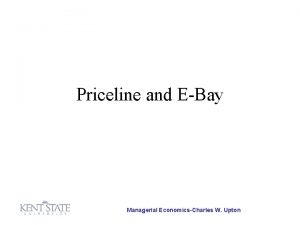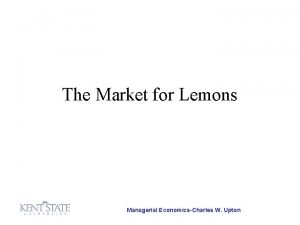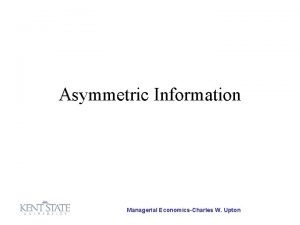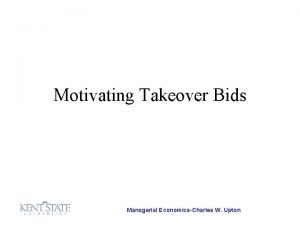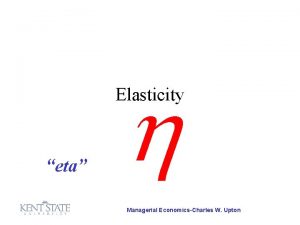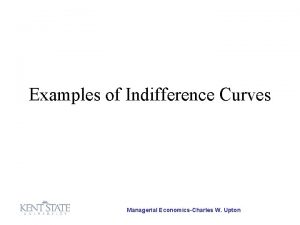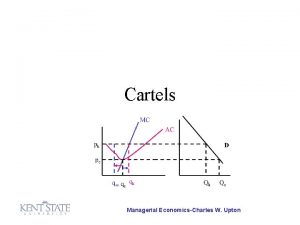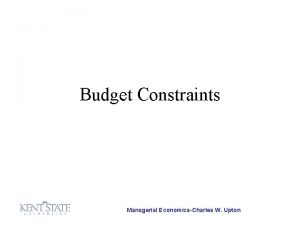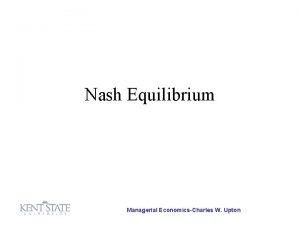Applying the Monopoly Model Managerial EconomicsCharles W Upton







































- Slides: 39

Applying the Monopoly Model Managerial Economics-Charles W. Upton

An Application • Lets do some simple applications, first mathematically and then using a spreadsheet. Applying the Monopoly Model

The Demand Functions Q = 100 – 2 P Applying the Monopoly Model

The Demand Function Q = 100 – 2 P MC = 5 Applying the Monopoly Model

Step One Q = 100 – 2 P MC = 5 • Find where MR = MC Applying the Monopoly Model

Finding MR R = PQ Applying the Monopoly Model

Finding MR R = PQ Q = 100 – 2 P P = 50 – (1/2)Q R = [50 -(1/2)Q]Q Applying the Monopoly Model

Finding MR R = PQ Q = 100 – 2 P P = 50 – (1/2)Q R = [50 -(1/2)Q]Q R = 50 Q – (1/2)Q 2 Applying the Monopoly Model

An Application Applying the Monopoly Model

An Application • We must find the derivative of our equation R = 50 Q – (1/2)Q 2 Applying the Monopoly Model

Derivative Review • The derivative of ax 2 + bx + c Applying the Monopoly Model

Derivative Review • The derivative of ax 2 + bx + c is 2 ax+b Applying the Monopoly Model

Derivative Review • The derivative of ax 2 + bx + c is 2 ax+b 50 Q – (1/2)Q 2 Applying the Monopoly Model

Derivative Review • The derivative of ax 2 + bx + c is 2 ax+b 50 Q – (1/2)Q 2 50 - Q Applying the Monopoly Model

Set MR = MC MR = 50 – Q Applying the Monopoly Model

Set MR = MC MR = 50 – Q MR = MC 50 -Q = 5 Q = 45 Applying the Monopoly Model

Step Two • What price will the monopolist charge? Remember the inverse demand function P = 50 – (1/2)Q Applying the Monopoly Model

Finding the Price • What price will the monopolist charge? Remember the inverse demand function P = 50 – (1/2)Q P = 50 – (1/2)(45) Applying the Monopoly Model

Finding the Price • What price will the monopolist charge? Remember the inverse demand function P = 50 – (1/2)Q P = 50 – (1/2)(45) P = 27. 5 Applying the Monopoly Model

Finding Price • Working from the demand function Q = 100 – 2 P Applying the Monopoly Model

Finding Price • Working from the demand function Q = 100 – 2 P 45 = 100 – 2 P P = 27. 5 Applying the Monopoly Model

Last Steps Quantity Price Revenue Cost Profit Applying the Monopoly Model

We Know Quantity 45 Price $27. 50 Revenue Cost Profit Applying the Monopoly Model

Revenue Quantity 45 Price $27. 50 Revenue =PQ Cost Profit Applying the Monopoly Model

Revenue Quantity 45 Price $27. 50 Revenue = (27. 5)(45) Cost Profit Applying the Monopoly Model

Revenue Quantity 45 Price $27. 50 Revenue = (27. 5)(45)= $1237. 50 Cost Profit Applying the Monopoly Model

Total Cost Quantity 45 Price $27. 50 Revenue $1237. 50 Cost = 5 Q = 5(45) = $225 Profit Applying the Monopoly Model

Quantity 45 Price $27. 50 Revenue $1237. 50 Cost $225 Profit = Revenue – Cost = $1227. 50 - $225 Applying the Monopoly Model

Quantity 45 Price $27. 50 Revenue $1237. 50 Cost $225 Profit $1012. 50 Applying the Monopoly Model

An Application • Find the value of Q at which MR = MC Applying the Monopoly Model

Review • Find MC Applying the Monopoly Model

Review • Find MC • Find MR Applying the Monopoly Model

Review • Find MC • Find MR – The Revenue Function is PQ Applying the Monopoly Model

Review • Find MC • Find MR – The Revenue Function is PQ – Solve for the inverse demand function Applying the Monopoly Model

Review • Find MC • Find MR – The Revenue Function is PQ – Solve for the inverse demand function – Substitute for P into the revenue function Applying the Monopoly Model

Review • Find MC • Find MR – The Revenue Function is PQ – Solve for the inverse demand function – Substitute for P into the revenue function Applying the Monopoly Model

An Application • Find the value of Q at which MR = MC • Find MR – Solve for the inverse demand function – Substitute for P into the revenue function – Find the derivative Applying the Monopoly Model

A spreadsheet approach • An alternative means of doing the problem is to build a spreadsheet. Lets work through that approach. Applying the Monopoly Model

End © 2003 Charles W. Upton Applying the Monopoly Model
 Upton sinclair birth and death
Upton sinclair birth and death Upton hall school fcj
Upton hall school fcj Charles upton
Charles upton Carolyn laorno
Carolyn laorno What was the jungle by upton sinclair about
What was the jungle by upton sinclair about Concrete jungle upton sinclair
Concrete jungle upton sinclair Progressive era dbq answers
Progressive era dbq answers Wes upton
Wes upton Upton sinclair accomplishments
Upton sinclair accomplishments Upton hall entrance exam papers
Upton hall entrance exam papers Wics model activities
Wics model activities Spmp2
Spmp2 Proiect managerial model
Proiect managerial model Managerial lever
Managerial lever Hát kết hợp bộ gõ cơ thể
Hát kết hợp bộ gõ cơ thể Slidetodoc
Slidetodoc Bổ thể
Bổ thể Tỉ lệ cơ thể trẻ em
Tỉ lệ cơ thể trẻ em Gấu đi như thế nào
Gấu đi như thế nào Tư thế worm breton
Tư thế worm breton Chúa yêu trần thế
Chúa yêu trần thế Các môn thể thao bắt đầu bằng tiếng bóng
Các môn thể thao bắt đầu bằng tiếng bóng Thế nào là hệ số cao nhất
Thế nào là hệ số cao nhất Các châu lục và đại dương trên thế giới
Các châu lục và đại dương trên thế giới Công thức tiính động năng
Công thức tiính động năng Trời xanh đây là của chúng ta thể thơ
Trời xanh đây là của chúng ta thể thơ Cách giải mật thư tọa độ
Cách giải mật thư tọa độ Phép trừ bù
Phép trừ bù Phản ứng thế ankan
Phản ứng thế ankan Các châu lục và đại dương trên thế giới
Các châu lục và đại dương trên thế giới Thể thơ truyền thống
Thể thơ truyền thống Quá trình desamine hóa có thể tạo ra
Quá trình desamine hóa có thể tạo ra Một số thể thơ truyền thống
Một số thể thơ truyền thống Cái miệng nó xinh thế
Cái miệng nó xinh thế Vẽ hình chiếu vuông góc của vật thể sau
Vẽ hình chiếu vuông góc của vật thể sau Biện pháp chống mỏi cơ
Biện pháp chống mỏi cơ đặc điểm cơ thể của người tối cổ
đặc điểm cơ thể của người tối cổ Ví dụ về giọng cùng tên
Ví dụ về giọng cùng tên Vẽ hình chiếu đứng bằng cạnh của vật thể
Vẽ hình chiếu đứng bằng cạnh của vật thể Fecboak
Fecboak


